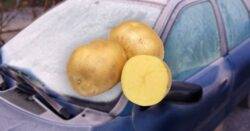Car experts have shared tips to help you drive safely in bad weather – including using a potato (Picture: Getty)
Car experts have shared tips on how to look after your vehicle in severe weather – including making use of a potato.
The John Clark Motor Group has shared eight tips to follow for staying safe in your car when commuting amid difficult weather conditions.
And some of them are quite unusual – including making use of the underside of a half a potato to clear your windscreen.
This is especially important given the damage that Storm Henk has caused in recent days, with many parts of the UK hit by serious flooding.
It has caused severe damage and even led to the death of one woman when she crashed her car into a fallen tree in Oxfordshire.
Experts recommend, where possible, that people don’t drive and stay off the roads in conditions like the UK has seen in recent days.
However, it also recognises that this is not an option for some people, and so it has shared eight key tips that drivers can follow if they do need to get behind the wheel.
Serious flooding has hit parts of the UK (Picture: PA News)
Travel across the UK has been impacted by the floods, including roads being blocked or closed (Picture: Getty)
Rub a potato on your windscreen
As strange as it sounds, this tip really does work. Rubbing the underside of a cut potato across your windscreen surface can help when it fogs over in freezing weather.
It can stop your windscreen from freezing during cold spells and it can even be a help when driving in the rain.
The starch in the potato acts as a barrier between the glass and air, so it can help prevent your windscreen from fogging up, making it difficult to see.
If you have to drive during bad weather, John Clark Motor Group recommends following its key tips (Picture: Getty Images)
Keep a safe distance
You should keep to at least double the normal distance between yourself and the car in front of you during heavy rain showers, especially the ones that appear to come out of nowhere.
Always keep an emergency kit in your boot
This may seem excessive but you never know what travel chaos the weather can cause, from crashes and break downs to long traffic jams, so it’s a good idea to have an emergency kit of supplies in your car at all times.
The kit could include a power bank for your phone, a warning triangle in case you break down, a stash of non-perishable food, water, torches, a thermal blanket or clothing and a high vis vest or jacket.
Among other tips, John Clark Motor Group recommends cutting a potato in half and rubbing it on your car windscreen (Picture: Getty Images)
Drive slowly and avoid standing water where possible
If you have to go through standing water, drive through it in first or second gear at around three to four mph.
Driving too fast could not only cause your tyres to lose contact so you skid and even crash, but you could splash a pedestrian which can leave you with a £150 fine and three penalty points.
Give other road users such as pedestrians, cyclists and motorcyclists more room as they are more likely to be blown around by high winds or be distracted and trying to avoid flooding.
Check your tyres
While the legal tyre depth is 1.6mm, this is a bare minimum and it’s recommended you aim for no less than 3mm.
To check it you can simply put a 20p coin into the groove and if you can’t see the outer band of the coin it means your tyres are above the legal limit.
Car experts say drivers should be prepared for every eventuality if they head out in severe weather (Picture: Manfred J. Bail
Provider: Getty Images/Westend61)
Avoid cruise control
While cruise control can be a very useful tool, you should avoid using it in heavy rain as more control is needed.
It’s also easy to let your brain switch off when you go into cruise control, but dangerous driving conditions mean you need to stay alert.
Get to know your car’s brakes
While you may have used your car’s brakes plenty of times, make sure you know the full extent of the braking system before you head out in bad weather, including how heavy or sensitive your brakes are.
Make sure you get to know your car’s brake system before heading out it bad weather (Picture: Getty Images Europe)
Fill up, charge up
It’s never a good idea to run out of fuel as it’s inconvenient at the very least, but can also lead to a £100 fine and three penalty points if you car blocks the road. This could be even more dangerous in bad weather conditions.
Make sure you fill up well before your fuel warning light comes on or, if you have an electric car, ensure you charge it overnight and have lots of range before setting off on your journey.
If you’re doing a long journey make sure you account for any fuel stops that are needed and adjust your route if necessary.
More: Trending
The recent stormy conditions have already caused a lot of destruction, from roads being closed and causing traffic jams elsewhere to flying debris to damaged vehicles.
The weather warnings around Storm Henk have said ‘flying debris’ is ‘likely’ because of high winds and said this ‘could cause injuries or danger to life’.
Get in touch with our news team by emailing us at [email protected].
For more stories like this, check our news page.
Car experts have shared their tips for driving in bad weather and severe rain.





